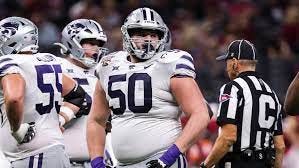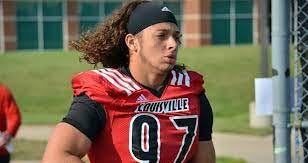There's life below the Heisman
Cody Schrader is just one of several players who deserve a break, if not a trophy
Next weekend, the top quarterbacks in college football will gather in New York. One will go home with a trophy featuring a fellow carrying a football and stiff-arming the world, or at least the football world as we knew it in 1954 or so.
Oh, Marvin Harrison Jr. of Ohio State, the deluxe wide receiver, might get an invitation, too, but you pretty much know that Bo Nix, Jayden Daniels, Caleb Williams and Michael Penix will be sitting up front. The Heisman Trophy has evolved, or devolved, from a flippant search for the “best player” to the identification of “best quarterback on a top five team.”
Who is the best college football player in the country? I don’t know and nobody else does. Some would point to the NFL draft, but then you’d have to accept first-overall picks like Dan Wilkinson, Jamarcus Russell and Courtney Brown.
Only three of the first 26 Heisman winners played quarterback exclusively. But fifteen of the last 17 Heisman winners are quarterbacks. The last running back to win it was Derrick Henry of Alabama in 2016. The last running back to win it who wasn’t from Alabama was Ron Dayne of Wisconsin, all the way back in 1999.
This is an accurate reflection of what football has become. No player in any sport bears more responsibility, pressure and stoicism than the QB. And with the overdue emphasis on identifying a true champion, the Heisman has taken on the look of what Most Valuable Player is in baseball, or used to be. You have to play on New Year’s Day or beyond to qualify.
But the Heisman winners are only the cover to the book of college football, and the thousands of stories therein. There should be a weekend for the local heroes, with umbrella drinks and boogie boards and manicures and all the earned benefits of a job well done. These are the guys who were consigned to Thursday nights or the CBS Sports Network (what did I do with my channel guide?).
Here’s a small sample of college football’s Special Guests:
Cody Schrader, RB, Missouri:
We can agree that 355 yards is a pretty sizeable hunk of turf. That’s the margin by which Schrader won the SEC rushing title. He had 1,489 yards and Daniels, of LSU, had 1,134. Schrader added 13 touchdowns, caught 22 passes, and was one of the engines behind Missouri’s 10-2 season and, for the moment, entry into the top ten.
Those who want Schrader’s acclaim probably don’t want any part of his path. He’s still only 5-foot-9 and 214, and he was a very cold commodity at Lutheran South High in St. Louis. Northern Colorado recruited him but then backed off. With nothing else going on, he looked to Truman State, formerly known as Northeast Missouri, in Kirksville, Mo.
He walked on, got into the lineup, and set 17 school records before he was through. Missouri coach Eli Drinkwitz came to St. Louis one day in hopes of recruiting star receiver Luther Burden. Before that, he had lunch with a donor, Steve Truslaske, and tried to convince him to let loose a check for Missouri’s facilities. Trulaske also had a favor. Through a mutual friend at a health club, he knew about Schrader.
Drinkwitz invited Schrader to try out, as a favor. Nine months later he was starting. On Saturday he became the first player in SEC history — that includes Herschel Walker, Bo Jackson and George Rogers for starters — to rush for 200 yards and catch for 100 in the same game, a blowout of Tennessee.
Talk about Showing Me.
“This is no longer just a feel good story,” Drinkwitz said. “He is a hell of a player.”
Cooper Beebe, G, Kansas State
Beebe has been Big 12 Offensive Lineman of the Year in back-to-back seasons. He could have turned pro in the spring but did not, and so all the other K-State linemen came back, too, and the Wildcats went 8-4. Beebe’s motivation is to be in the program’s Ring of Honor. The NFL is likely to reward his loyalty by making him a first-round pick.
Beebe, listed at 6-foot-4 and 336 pounds, has allowed one sack in his past 1,224 snaps at K-State, although he has played three different positions. He started a sackless streak when he was playing tackle, which doesn’t suit his body type. It’s been quite a ride for a guy from Wichita who was only offered scholarships by Kansas, Kansas State and Minnesota, and when he visited Kansas, one of the assistant coaches told him, accurately, “Don’t come here. We’re getting fired.”
Beebe also thought he’d be playing defense at first. He was redshirted, and given No. 50. “That means you’re on offense,” said Tom, his father, who played at Pittsburg State in Kansas. The Wildcats’ coaches thought Beebe was a bust at first, but, going back to Bill Snyder’s days, they always play the long game. Check your recruiting stars at the door, and get better incrementally.
Beebe has done that, and it’s a testament to football families. His brother Colton played at Minnesota, brother Camden is a Kansas State teammate, and brother Collin played in his high school before he came to K-State. Cooper wanted to graduate so he could qualify as a teacher someday. That’s a worthy goal that leads right into coaching, but maybe not quite yet.
Ashton Jeanty, RB, Boise State
Jeanty missed two and a half games this year but still ranks second nationally in all-purpose yards and has rushed for 1,113. It’s been a strange year on the blue turf, with Andy Avalos getting fired, and yet the Broncos rallied to play UNLV in Saturday’s Mountain West championship game. Jeanty has been the constant.
He grew up in a military family and lived in Italy before he moved to suburban Dallas. He didn’t get much notice or film time, and when he did he was running around and through kids from other military families. At Lone Star High in Frisco, Tx., Jeanty had to bide his time behind people like Marvin Mims, who became an Oklahoma receiver and then went to the Broncos. Jeanty even played safety and linebacker at times.
But in his senior year, he scored 41 touchdowns. Kansas was the only “power conference” school that responded, and by then Jeanty was sold on Boise State.
“If he’d been playing running back all along I think he’d be at Texas or Alabama,” said Jeff Rayburn, his high school coach. “Boise State and the state of Idaho have us to thank for that.”
Frank Harris, QB, Texas-San Antonio
Harris leads the Covid-19 generation. Counting a redshirt year, a medical redshirt year, and a compensatory year for the pandemic, this was his seventh season. He turned 24 last spring. The lefthander has become something of an institution in the city, leading UTSA to the Conference USA championship in 2022 and then taking the Roadrunners into the American Athletic Conference and finishing with an 8-4 record.
When Harris announced he was returning, the boosters were in the process of setting up a collective. His press conference that was attended by a Bexar County judge and a former mayor. Harris has symbolized the progress of a 12-year-old program that sent offensive coordinator Will Stein to Oregon last year and had done so well that head coach Jeff Traylor was rumored to be a candidate at Texas A&M.
The toughest part for Harris is escaping MRIs. He had four surgical procedures on an infected knee, coming into this year. He tore an ACL while quarterbacking at Schertz, a suburb of the Alamo city, and then another when he was a Roadrunner freshman. Then Harris had shoulder problems. But he eventually carved out a 39-12 record as UTSA’s quarterback and, with Daniels, is one of two quarterbacks with 11,000 passing yards and 2,000 rushing yards.
What’s next? Well, probably a lot of football, somewhere. But Harris has taken care of his own playbook, with a bachelor’s in sociology in 2011 and a master’s in public administration in 2013.
Ashton Gillotte, edge, Louisville
When Gillotte gets going upfield, his hair escapes his helmet on both sides and makes him resemble a speeding Porsche with all doors open. Nowadays, a player like Gillotte can actually make money off that. You can get a “Beware Of The Hair” T-shirt in Louisville these days, and Gillotte will get a cut. But quarterbacks in the ACC don’t need a reminder.
Gillotte had 11 sacks for the Cardinals, who won 10 games and will play Florida State in the ACC title game on Saturday. Like so many, he caught up with the top recruits as he matured. He was only a 3-star from his Boca Raton, Fla. high school, but he had relatives in Ohio, near Louisville, and liked the chance for playing time. He didn’t know his coach, Scott Satterfield, would be leaving for Cincinnati, but the Cardinals hired one of their legends, Jeff Brohm, from Purdue, and also defensive coordinator Ron English, who helped set The Hair on fire.
Gillotte’s parents both enjoyed CrossFit training and brought him along. Because his mom Veronica taught him the fundamentals, Gillotte took a liking to weightlifting and qualified for powerlifting meets in Florida. He has power-cleaned 400 pounds and yet also learned yoga from his parents, which means Gillotte can always bend. He already knew how to break.








Not his fault, but Bowers missed too many games. Harrison probably wlill be the best pro but he cut his route off Saturday and contributed to that interception. Hard to argue with Nix.
Bowers and Harrison are the best players, IMO.